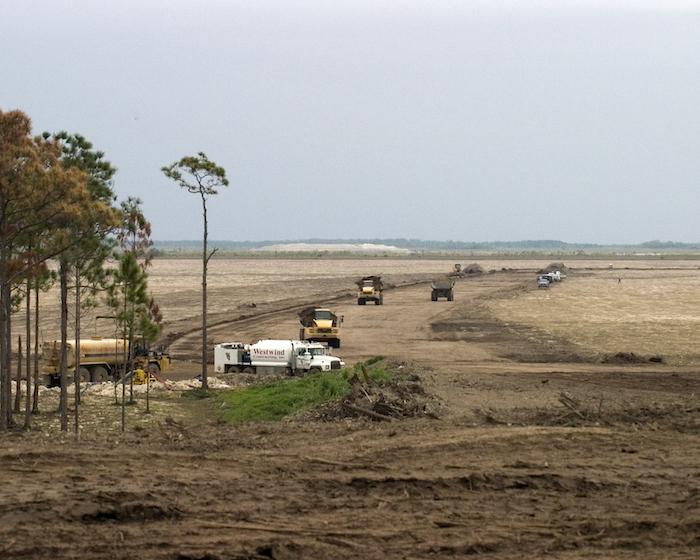
EVERGLADES NATIONAL PARK _ It was an unlikely scene in a national park established to protect nature: bucket excavators, lumbering dump trucks, and bulldozers, heavy equipment more common at sprawling construction sites, were rummaging through the muck not far from the park's Ernest F. Coe Visitor Center.
They were not, however, deconstructing nature, but rather restoring it by recreating a natural environment conducive to the Muhly and sawgrass prairie near the southern end of Long Pine Key that once bordered Taylor Slough before giving way to tomato fields prior to Everglades National Park's establishment and then decades later, to a dense forest of nonnative Brazilian pepper trees.
"All of the farmland was acquired between 1970 and 1975," Jonathan Taylor, the park's restoration program manager, explained as we stood on the fringe of the excavation project. "The nice thing about this [tomato farming] is that they could do this during the winter when the rest of the United States was unable to produce fresh produce. And so it was a very profitable farm commodity. Harvest the tomatoes and send fresh tomatoes up to the rest of the United States."
Not long after the farming ended, however, the park's resource managers noticed that a new vegetation was creeping across the landscape, a nonnative plant from South America brought to the United States in the late 1890s and early 20th century as an ornamental tree. Reaching a height of 30 feet or so, the trees bear clumps of red berries that stand out against the green foiliage and explain their "Christmas holly" nickname.

Farmland once sprawled across the landscape at Everglades National Park/NPS
Beautiful as they might be, Brazilian pepper trees (Schinus terebinthifolius) are highly invasive, so much so that the state of Florida considers them noxious weeds, calls for their removal, and has made it illegal to sell them without a state permit. Compounding the problem is that two different genetic varities of the tree were imported into the United States, and in Florida the two hybridized and produced a sturdier, faster growing tree that can overwhelm landscapes. They also have a sap that, for some who come in contact with it, generates an allergic rash as the tree is related to poison ivy, poison oak, and poisonwood.
Sharon Ewe, a principal scientist with the international consulting firm Stantec who has a specialty in wetlands vegetation, said an aspect of Brazilian pepper that makes them particularly hardy in coastal areas is their practice of sending deep roots into the soil along with a finer network of roots that runs close to the surface. That way, if the groundwater becomes too saline, the surface roots can take in any available freshwater.
"It has a mechanism of being able to shut down in saltwater environments. It's able to tolerate flooding of its roots," she said during a phone call from her Tampa, Florida, office. "One of the mechanisms, in addition to physiological, that it does to cope with these stressful conditions, besides shutting down, is that it also produces a lot of very fine roots. So basically, when conditions are not good two feet below ground, they'll produce roots in the shallower regions and minimize exposure" to saltwater.
Also problematic for Everglades native vegetation is how dense Brazilian pepper forests become, Taylor said as we watched the heavy machinery at work in the Hole-in-the-Donut, a curious name that apparently stems from how the landscape looks from the air -- the farmland-turned-Brazilian pepper forest was the hole surrounded by the subtropical vegetation of the national park.
"There’s very little growing underneath the understory, very little biodiversity underneath this forest of Brazilian pepper," he said. "That’s exactly what this invasive species does, it dominates the site, takes over, and out-competes all of the native plant species. You’ll find very little native plant species underneath this particular patch of Brazilian pepper, and that’s what the 'Hole-in-the-Donut' was. It was almost nearly one montypic forest of this plant.”
With Brazilian pepper having arrived in Florida in the late 19th and early 20th centuries and having found beneficial growing conditions in the wilds, once the tomato farm operations were shut down the invader quickly arrived, probably helped by birds that ate its berries and distributed seeds through their droppings.
While at its peak Brazilian pepper spread across 6,300 acres in this corner of the park, an intensive eradication program begun in the late 1980s succeeded in removing all but 200-250 acres by 2022. By year's end, the final acreage should be cleared of the invader.
Making the work fiscally feasible was the decision to use the landscape as a wetlands mitigation bank, tthe first in Florida and the only one in the National Park Service. Through it, companies that need to mitigate environmental impacts from development projects in Miami-Dade and Broward counties can "purchase" credits in the mitigation bank.
“All of those costs, into perpetuity, are covered by the fee that people who need mitigation for their impacts, they can pay into the program," said Taylor. "That’s what funds the activities that you see here.”
But the success hasn't been easy.
“None of the traditional resource management techniques for restoration were successful," he explained. "Three things played a role in allowing the Brazilian pepper to be so competitive. Some interaction of those three things -- the nutrients, the plowing [during the farming period that created a favorable growing medium for the invader] and the decreased hydroperiod allowed for Brazilian Pepper to be just particularly successful in outcompeting all of the native plants that may have tried to colonize the site after farming.
“They tried mowing, they tried to do burning, and none of those techniques prevented the Brazilian pepper from dominating the site," he went on. "And it was only somewhat by accident that they stumbled upon the technique that you see behind you, that has been used since the inception of the project, which is ultimately to remove all of the farmed soil from the limestone bedrock."
That soil, the "spoils" left over from the farms, is stored in mounds roughly 25 acres in size that are quickly recolonized by native vegetation.

Restoring more than 6,000 acres of the "river of grass" is almost complete/Patrick Cone
Once those soils have been removed, nature takes over, as Taylor showed me when we drove to a nearby site that had been cleansed of Brazilian pepper in 1989.
"This is what we aspire to for the rest of the site," he said as we stood in calf-deep water -- a section of the "river of grass" that flows from Lake Okeechobee down to Florida Bay -- surrounded by sawgrass, Muhly grass, and other native vegetation. "We have 30 years of data, all of our restored sites are trending towards this outcome, and this area continues to get closer and closer to what the undisturbed natural areas look like. So this is undoubtedly a success.”
“What made this project so successful is that we could remove the soil, and then we sit back and let natural processes take over," said Taylor. "All of these native plant species, they’ve come in on their own. And the hydrology is restored, just as a natural function of us having removed the soil. We are able to have prescribed fire. All of these things we can just let happen of their own accord. We don’t have to jumpstart that any more, just by removing the soil.”
Those prescribed fires, which mimic natural fire that occurs on the national park's prairies, help keep the Brazilian pepper from returning and allow the native grasses to flourish.
"There will be some level of ongoing maintenance at the edges," said Ewe. "But, no, the strategy and the reason why the Hole in the Donut has been so successful is they basically scraped it down to bedrock. So there is no more substrate, as it were, for Brazilian pepper to grow. They returned it to normal, Muhly grass, marsh and prairie. And if it's all natural habitat, like upland habitat, it should be able to withstand a rotation of fire cycles."
While the battle with Brazilian pepper has been successful at the Hole in the Donut, climate change is making South Florida more amenable to other invasive species, which will very likely have park staff constantly working to keep the invaders out.
"It's going to make it more amenable to certain species, for sure," said Ewe. "Which ones will be the winners? We're not quite sure yet. It may be something that hasn't even landed on our shores yet."



Add comment